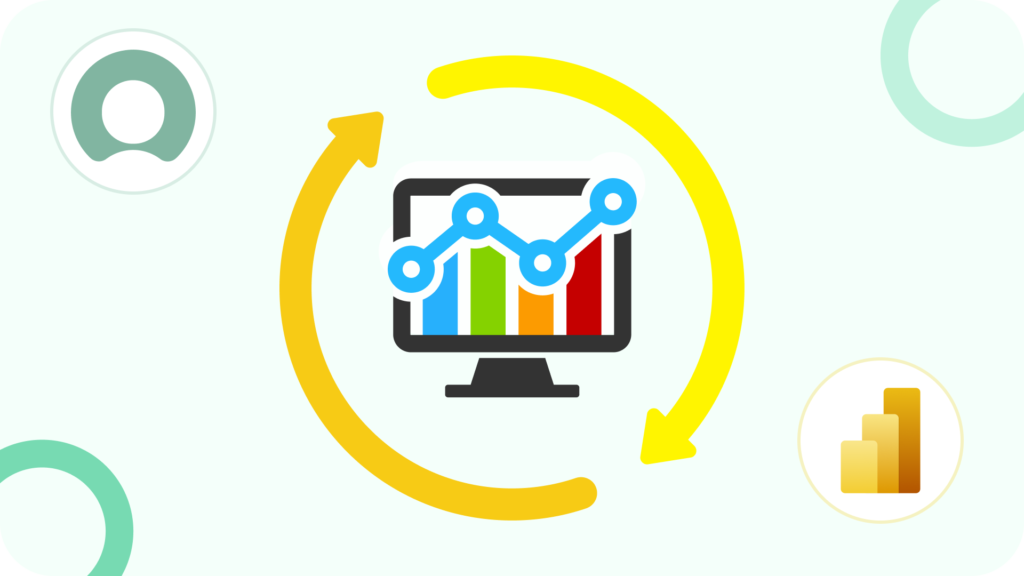Effective reporting enables organizations to make well-informed decisions and foster business growth. However, users of ServiceNow often require assistance in extracting, analyzing, and visualizing data from the platform. It can result in reporting processes that are both time-consuming and expensive. The ServiceNow Power BI integration offers significant potential for organizations that combine the rich graphical representation of complex ServiceNow data, flexible custom analysis supported advanced ServiceNow reporting.
Learn how integrating Power BI with ServiceNow may improve reporting capabilities at your company, which can result in cost savings. Additionally, we go through common reporting challenges ServiceNow users run into and explain how to fix them. The exciting section is when we discuss integrating ServiceNow with Power BI and analyzing each way’s pros and cons to find the best solution for various scenarios.
- ServiceNow Reporting Challenges
- What is ServiceNow Power BI Integration and Why it Resolve Those Issues
- Benefits of ServiceNow Power BI Integration
- Ways to Perform ServiceNow Power BI Integration
- Conclusion

ServiceNow Reporting Challenges
ServiceNow is a powerful platform that offers a wide range of features to help organizations streamline and optimize their business processes. However, ServiceNow users frequently experience substantial reporting issues that limit their capacity to gain valuable data from the platform. The ServiceNow reporting tools have few built-in features, one of the main drawbacks. Despite the platform’s basic reporting capabilities, users complain that customization choices, complex data visualization, and in-depth analysis must be improved. This constraint limits the capacity to develop complex and customized reports that are focused on the organization’s needs.
Another issue is that ServiceNow reporting functions can only be accessed through the ServiceNow instance. This restriction could put challenges in the way of parties outside the ServiceNow ecosystem who need access to reports and analytics. The problem of getting a comprehensive view of the organization’s data is made more difficult by the inability to share reports with external teams in an easy manner or to combine ServiceNow data with other software solutions becomes complex and time-consuming. It can cause fragmented views of data that delay the required preventive actions, making it more difficult for the business to react swiftly to shifting market conditions.
However, the most pressing pain point lies in the process of creating consolidated reports. Extracting data from various sources, synchronizing and consolidating it, and generating comprehensive reports can be a time-consuming endeavor, typically taking 2 to 3 weeks. Unfortunately, by the time these reports are completed, they are already based on outdated data, rendering them potentially obsolete to oversee all business processes to make strategic and operational decisions in a timely manner that can provide a competitive advantage for the company, as well as effectively solve any issues the company may come across.
What is ServiceNow Power BI Integration and Why it Resolve Those Issues

Organizations using ServiceNow must seek solutions that streamline consolidated reporting and data extraction to address these challenges. By leveraging integrations and tools that facilitate efficient ServiceNow data consolidation and extraction, ServiceNow users can minimize delays and ensure reports are based on current and accurate data. It empowers organizations to enhance responsiveness, gain real-time insights, and make decisions that drive business success.
ServiceNow Power BI Integration is the best possible transformative solution that addresses the issues ServiceNow users face. By combining the capabilities of ServiceNow and Microsoft Power BI analytics platform, organizations using ServiceNow can overcome the challenges, unlock a new level of ServiceNow reporting efficiency, and provide effectiveness through advanced data visualization, powerful reporting functionalities, and flexible, in-depth analysis tools offered by Power BI.
The ServiceNow Power BI integration also enables the integration of ServiceNow data with other external data sources, providing a holistic view of the organization’s information and enhancing the accuracy and relevance of consolidated reporting. Furthermore, Power BI real-time data processing capabilities ensure that reports are based on the most up-to-date and relevant information. It addresses the challenge of obsolete reports resulting from delayed extraction and consolidation processes. Due to Power BI integration, ServiceNow users can not only generate complex reports on time, enabling faster making decisions based on current data facts. It also allows business analysts to focus on analytics and business insights instead of spending time on technical aspects of integration, data reconciliation or ensuring data quality.
Benefits of ServiceNow Power BI Integration

ServiceNow Power BI Integration brings a host of benefits that enhance ServiceNow reporting capabilities and enable organizations to derive helpful insights and critical data facts. Establishing ServiceNow Power BI connectivity opens up new possibilities for data analysis and reporting. Here are the key benefits:
Expanded ServiceNow Reporting Capabilities
Organizations using ServiceNow are no longer constrained by the platform’s built-in reporting features thanks to ServiceNow Power BI Integration. Now, ServiceNow customers may create any report they desire to fit their unique reporting needs, whether it is to measure changes in performance over time (see the traction) or monitor real-time Key Performance Indicators (KPIs).
Enhanced Power BI Dashboard and Report Creation
The integration of ServiceNow with Power BI allows for the generation of multiple reports and dashboards that can be adapted according to the needs of different teams, stakeholders, departments, and levels of management. The ability to adjust ensures that the correct data is delivered to the just right audience at the perfect time. Power BI integration provides flexible operational reports for day-to-day activities and executive-level dashboards to assist with strategy decisions.
Consolidated Reporting across Data Sources
Integrating ServiceNow with Power BI enables the combination of ServiceNow data with other data sources (CRM, Jira, ERP etc). This connection offers a comprehensive view of the organization’s performance by consolidating data from different business functions. By allowing them to evaluate and visualize data wholeheartedly, analysts are able to find key information and establish interactions between diverse business-related aspects.
Easy Sharing of Power BI Reports
ServiceNow Power BI connection makes it simple to share reports and analytics. Those who don’t have direct access to the ServiceNow instance can still receive Power BI reports with ease. This convenient report sharing offered by Power BI promotes collaboration, aids in data-based reasoning, and facilitates effective internal and external stakeholder communication.
Ways to Perform ServiceNow Power BI Integration

Several methods are available for integrating ServiceNow and Power BI, each with a set of pros and cons. Below are the commonly used integration methods, along with their potential benefits and considerations:
Method 1: REST API
Connecting ServiceNow to Power BI using the REST (REpresentational State Transfer) API (Application Programming Interfaces) allows direct communication between the two platforms. Through RESTful APIs, ServiceNow exposes its data and functionalities as resources that can be accessed and manipulated by external systems like Power BI. In turn, Power BI can utilize REST APIs to retrieve data from ServiceNow, perform transformations, and visualize it in a meaningful way for reporting and analysis.
REST APIs enable ServiceNow and Power BI to communicate using standard HTTP methods, such as GET, POST, PUT, and DELETE. These methods allow Power BI to request specific data from ServiceNow, send updates, or perform other operations as needed. The responses from ServiceNow are returned in a format such as JSON (JavaScript Object Notation) or XML, which Power BI can easily consume for further processing and visualization.
Pros of REST API Method
1. No Need for Additional Plugins or Solutions
REST APIs are a standard feature in many modern applications, including ServiceNow and Power BI. Organizations can leverage the existing REST API functionality without requiring additional investments or dependencies on third-party tools.
2. Cost-Effective Solution
Since the platforms already have the APIs, ServiceNow REST API integration comes free of price. The REST APIs offered by ServiceNow and Power BI do not require organizations to pay additional fees in order to access and use them. This does not include the cost of resources for the integration development, of course.
3. Flexibility and Control
Organizations can set up custom endpoints, query parameters, and data filters to access exact data for reporting and analysis. With this level of control, users can get data according to reporting needs and analyze the most relevant data.
4. Standardized Approach
REST APIs follow standardized principles that are extensively used and compatible to extract ServiceNow data and import it into Power BI for customized reporting and analysis, allowing companies to pick key data fields, apply transformations, and build customized visualizations with REST API connection.
Cons of REST API Method
1. Technical Expertise
Organizations must have sufficient skills, technical experience, and knowledge of API usage, authentication procedures, and data retrieval strategies to design and manage the connection. REST API commands are complex, and mistakes might cause errors or unsatisfactory integration results. Additionally, the team should be well familiar with ServiceNow data architecture.
2. Data Limitations
REST API integration scalability is essential when data volumes grow or reporting needs change. REST API connectors limit data retrieval by default. ServiceNow limits retrieval to 2 minutes and 50,000 records. ServiceNow transaction quota rules may need to be modified to obtain larger datasets, adding complexity and administrative burden.
3. Time-Consuming
Integration with REST APIs takes longer than alternative approaches. Defining endpoints, handling authentication, and guaranteeing data consistency takes time and effort. For smooth integration, provide sufficient planning, implementation, and testing time.
4. Manual Refresh
REST API integration does not support incremental refresh in Power BI. Updates to reports and dashboards require manual data refreshment that takes time and delays data analysis and taking decisions.
5. Complicated Filter Building
REST APIs make complicated filter creation difficult. Organizations may need assistance creating complex filtering criteria to collect data for reporting and analysis that affect integration efficiency and accuracy.
6. Data Representation and Conversion
REST APIs use strings without typing. Thus, data conversion into integers, booleans, decimals, etc., requires more effort. While ensuring proper data conversion is crucial to maintain data integrity and accuracy within Power BI.
Method 2: CSV Files
Using CSV (comma-separated values) files for data transfer is another way to perform ServiceNow Power BI integration. Although this strategy is frequently thought of as being simpler one than other integration techniques, it has several drawbacks.
The ability to export and import data in a text-based format makes CSV files a popular and universal file type useful for moving data between different platforms. Exporting the needed data from ServiceNow into a CSV file format, then importing it into Power BI, is how CSV files are used for integration. After getting the CSV file, users can import it into Power BI to report and analyze the information that was transferred.
Pros of CSV Files Method
1. Time Efficiency
Compared to other integration methods, using CSV files for data transfer can be relatively quick and straightforward. Exporting data from ServiceNow into CSV files and importing them into Power BI can be done efficiently, allowing users to access and analyze the transferred data quickly.
2. No Additional Products or Costs
Using CSV files for integration does not require additional products or licenses. Since CSV files are a widely supported file format, there is no need for specialized connectors or plugins, reducing the need for additional investments.
Cons of CSV Files Method
1. Non-effective Manual Work
As every update requires manual data extraction from ServiceNow, it can be very ineffective and time-consuming for bigger organizations. Additionally, as the data has been once extracted, the time spent on report building makes the data obsolete when the report is ready. Using CSV files is generally considered less complex, it still requires some knowledge and familiarity with the process.
2. Performance Dependency on SharePoint
If SharePoint is used as an intermediary platform for storing and transferring CSV files, the performance of the integration process can be impacted by SharePoint’s functionality and overall health. Any issues with SharePoint could affect the smoothness and reliability of the data transfer.
3. Time Consumption
Depending on the volume of data and the complexity of the export/import processes, using CSV files for integration can still take a considerable amount of time. Users must allocate sufficient time to export data from ServiceNow, ensure proper CSV formatting, and import the data into Power BI.
4. Limitations in Power BI Refresh Cycles
CSV files do not support real-time data synchronization, and Power BI has limitations on the frequency of data refreshes. As a result, the data in Power BI may only sometimes reflect the most up-to-date information from ServiceNow, requiring manual updates or scheduled refreshes to keep the data current.
5. Data Typing and Conversion
CSV files represent data as strings without explicit typing. It requires additional effort to convert and format the data into the desired target types, such as integers, booleans, decimals, etc. Ensuring accurate data typing and conversion in Power BI is necessary to maintain data integrity and enable accurate analysis.
Method 3: CData
The CData method for ServiceNow Power BI integration involves using the CData Connector, a specialized 3-party tool that enables a connection between ServiceNow and Power BI. The CData ServiceNow Connector facilitates integration between ServiceNow and Power BI by providing standardized metadata information.
This metadata enables Power BI to recognize and classify data fields in ServiceNow, such as text, numerical, location, date/time, and more. By understanding the data types, Power BI can effectively generate meaningful charts, reports, and visualizations that accurately represent the underlying data from ServiceNow. The CData ServiceNow Connector ensures that Power BI appropriately interprets and utilizes the data, enhancing the overall analytical capabilities and insights derived from the integrated data.
Pros of CData Method
1. Customizable Data Mapping
The CData Method offers flexible data mapping capabilities, allowing users to define how data from ServiceNow is mapped to Power BI. This customization enables organizations to tailor the integration to their specific data requirements. It ensures that the data is presented in a format that aligns with their reporting and analysis needs.
2. Comprehensive Metadata Support
The CData Method provides comprehensive metadata support, delivering detailed information about the structure and characteristics of the ServiceNow data. It includes data types, relationships between tables, and other relevant metadata. The availability of such information enhances the data exploration and analysis capabilities in Power BI, enabling users to make informed decisions based on a thorough understanding of the data.
3. Compatibility with Custom Views
The CData Method allows for seamless integration with custom views created within ServiceNow. Custom views provide a way to organize and filter data based on specific criteria, enabling users to extract targeted data subsets that align with their reporting needs. The compatibility with custom views enhances the flexibility and accuracy of the data retrieved from ServiceNow into Power BI.
Cons of CData Method
1. Lower Performance
The connector interacts with data through an intermediary layer, which may degrade performance. The additional abstraction layer may slow power BI data retrieval and analysis. Organizations should assess their reporting and analysis procedures to guarantee the CData ServiceNow Connector achieves performance objectives and integration goals.
2. Limitations with Dot-Walking Field Data
Dot-walking is a ServiceNow feature that allows users to access related data by traversing through relationships between tables. The CData Connector may need to provide a more straightforward way to retrieve dot-walking field data, which could limit the depth of data analysis in Power BI.
3. Global Display Value Setting
When using the CData Connector, the display value for fields can only be set globally rather than on a per-field basis. This limitation may impact the ability to customize the display values for specific fields based on reporting requirements.
Method 4: Power BI Connector for ServiceNow
The Power BI Connector for ServiceNow is a specialized app designed to facilitate the integration between ServiceNow and Microsoft Power BI. Its user-friendly interface connector enables users to directly connect to ServiceNow and extract data from any ServiceNow tables and fields for analysis and visualization in Power BI. It allows streamlined export of ServiceNow data and creates multiple datasets within a single data source in Power BI.
The Power BI Connector for ServiceNow serves as a bridge between 2 platforms on the way of leveraging the comprehensive features of Power BI to analyze and visualize ServiceNow data, unlocking valuable insights and enhancing data-driven decision-making processes. The Power BI Connector for ServiceNow is the exclusive solution available in the ServiceNow store for integrating these two platforms.
Pros of Power BI Connector for ServiceNow
1. User-Friendly Interface
The Power BI Connector for ServiceNow offers an intuitive and easy-to-use interface. It does not require coding or advanced technical skills, making it accessible to many users. The simplicity of the connector allows for a smooth integration experience without the need for extensive training or expertise.
2. Quick Installation and Setup
Installing and using Power BI Connector for ServiceNow is a straightforward process that takes only a few minutes. Users can quickly set up the connector and extract ServiceNow data into Power BI, minimizing downtime and enabling faster data analysis and reporting.
3. Extensive Filtering Options
The ServiceNow Power BI connector provides extensive filtering options, allowing users to export multiple ServiceNow tables within a single data source selectively. This flexibility lets users focus on specific data subsets and tailor the integration to their reporting needs, improving efficiency and data management.
4. Power Query Support
The Power BI Connector for ServiceNow supports Power Query, a powerful data transformation and merging tool to combine ServiceNow data with other sources, enhancing the depth and breadth of data analysis in Power BI.
5. Scalability and Data Pagination
The connector has no limitations on the amount of data that can be exported. To optimize server load during the export process, the connector utilizes server-side pagination over the OData protocol, allowing for efficient extraction of large datasets (limited to 1,000 rows per page).
6. Data Access Control
The connector provides role-based access control, allowing users complete control over who can access and use the exported data within the application. It enhances data security and privacy by ensuring only authorized individuals can interact with the integrated data.
7. Typed Exported Data
The connector exports data with proper data typing, eliminating the need for manual data type conversions. It ensures data integrity and reduces the potential for errors during data analysis in Power BI.
Cons of Power BI Connector for ServiceNow
1. Third-Party Application Requirement
Users need to install a third-party application to utilize the Power BI Connector for ServiceNow. It introduces an additional step and dependency on an external tool for the integration process. But need to mention that it is a Built-on-Now app developed by a certified Build ServiceNow Partner. The application has been approved by ServiceNow and is published on the ServiceNow Store.
2. Paid Application
Unlike other integration methods, the Power BI Connector for ServiceNow is not free. Users need to purchase a license to use the connector for each production ServiceNow instance, which adds a cost consideration to the integration solution. The good thing is that there is a qualified support provided by the vendor for no cost, as well as all new versions are available during the contract time.
Conclusion
In conclusion, integrating ServiceNow and Power BI can significantly enhance an organization’s reporting and analysis capabilities. The various integration methods offer distinct benefits and considerations, such as REST API, CSV Files, CData, and Power BI Connector for ServiceNow. Considering the pros and cons of each integration method, organizations can choose the best approach with their specific requirements, technical capabilities, and budget. Whichever method is selected, the ServiceNow and Power BI integration opens up a world of possibilities for organizations to optimize their reporting efforts, drive efficiency, and make informed decisions based on accurate, up-to-date data.
About acSoft Blog
The acSoft blog is your window into the core of ServiceNow, guided by experts who have molded the platform’s capabilities to drive innovation and efficiency. Our contributors are not just observers but active participants in the ServiceNow ecosystem, bringing firsthand experiences and insights. They dissect complex features, share pioneering research, and provide a narrative that bridges technical expertise with strategic foresight.

